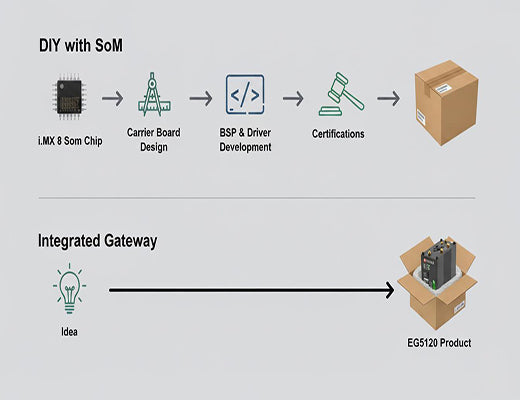
i.MX 8 System on Module: A Faster Path from Prototype to Production
|
|
Time to read 6 min
|
|
Time to read 6 min
For engineers developing a new edge device, choosing an imx8 system on module is a popular starting point due to its power and flexibility. However, the path from a bare SoM to a market-ready product is filled with hidden costs and delays.
This guide compares the traditional SoM and custom carrier board approach with using a fully integrated, pre-certified industrial edge gateway.
We'll show you how a solution like the Robustel EG5120, powered by the nxp imx8 som, can drastically reduce your hardware development effort and accelerate your time to market.
If you're an embedded systems engineer, you know the NXP i.MX 8 series. Its powerful multi-core ARM architecture and advanced processing capabilities make it a top choice for demanding edge computing applications. Naturally, starting your design with an seems like a logical first step. It gives you a powerful core and the freedom to design a custom solution around it.imx8 system on module
But what if that freedom comes at a hidden cost? A cost measured not just in dollars, but in months of engineering effort, frustrating development cycles, and delayed product launches. In my experience, the real challenge isn't the SoM itself; it's everything that comes after. Let's explore a smarter, faster path from your i.MX 8 concept to a globally deployed product.
arm system on module based on this processor gives your project a massive head start with a proven computational core. embedded system on module is a small board that contains the most complex parts of an embedded system: the processor, RAM, and flash storage. Engineers choose SoMs to handle the high-speed, complex part of the design so they can focus on creating a custom carrier board that holds the unique I/O and interfaces for their specific application. It's a great strategy for creating highly customized hardware.The i.MX 8, and specifically the imx8m plus module, is sought after for good reason. It offers:
It's the perfect brain for a next-generation edge device. But a brain needs a body.
Your product isn't finished until it's certified. Getting your custom hardware through regulatory testing for CE (Europe), FCC (USA), IC (Canada), and other global standards is a massive, expensive, and time-consuming hurdle. A single failure can force a costly redesign and add months to your timeline. This is often the stage where promising projects face critical delays.

hardware development pain and get straight to working on your application? That's the value proposition of a fully integrated industrial edge gateway.The Robustel EG5120 is an industrial gateway built around the very same high-performance NXP i.MX 8M Plus processor you're evaluating. But it's not just a processor on a board. It is a complete, market-ready product that includes:
carrier board with a rich set of industrial I/O (RS485, Gigabit Ethernet, Digital Inputs/Outputs). Docker support.
Let's be honest about the total cost. While a bare might have a lower upfront price, the Total Cost of Ownership (TCO) tells a very different story.imx8 system on module
Metric |
DIY with i.MX 8 SoM |
Integrated Gateway (e.g., EG5120) |
Time-to-Market |
12 - 24 months |
1 - 3 months |
Upfront Hardware Cost |
Low (for SoM only) |
Medium |
R&D Engineering Cost |
Very High (Hardware & Software teams) |
Very Low |
Certification & Lab Fees |
Very High ($50k - $100k+) |
Included |
OS & Security Maintenance |
High (Your responsibility) |
Included (Managed by vendor) |
Total Cost of Ownership |
VERY HIGH |
LOW |
Learn More:
[The Real Cost of Developing an Electronic Product]
The choice becomes clear. While the DIY path offers maximum customization, the integrated gateway path offers maximum speed, minimum risk, and a dramatically lower TCO.
Learn More:
[A Deep Dive into IoT Edge Devices]

The primary reason is to accelerate time to market. A pre-certified, fully integrated gateway like the Robustel EG5120 eliminates 12-24 months of custom hardware design, software development, and regulatory certification, allowing you to focus on your application instead of reinventing the core hardware platform.
The key benefits of the NXP imx8m plus module inside the EG5120 are its powerful quad-core ARM CPU for running complex applications, and its integrated 2.3 TOPS NPU, which provides dedicated hardware acceleration for running demanding AI and machine learning models directly at the edge.
That's a valid concern, but with modern gateways, the answer is no. A device like the EG5120 runs RobustOS Pro, which is based on a standard Debian 11 environment and provides full Docker container support. This gives developers a familiar, open-source Linux environment where they can deploy virtually any custom application. You get the software freedom of a custom build without the hardware development and certification headaches.